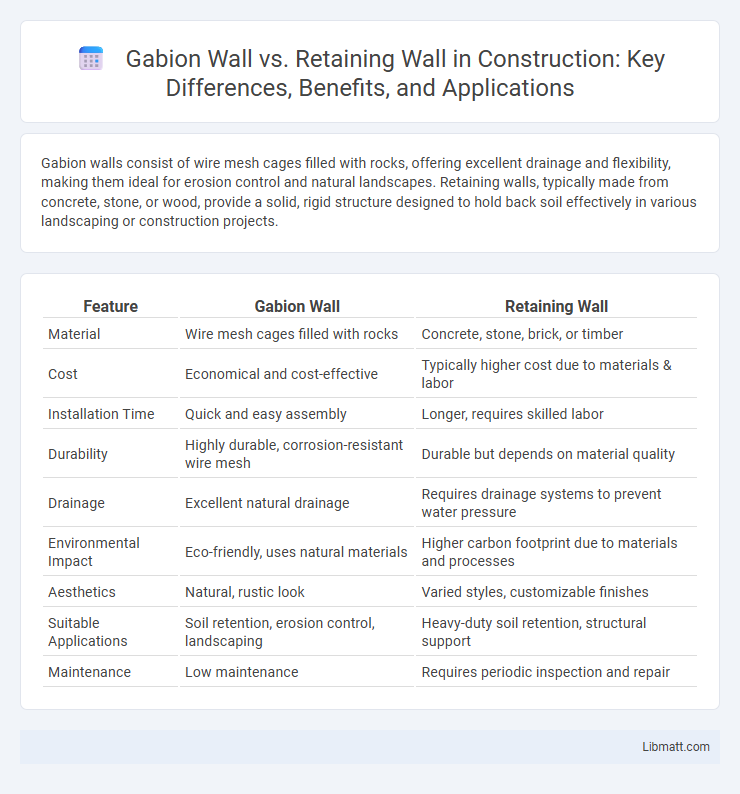Gabion walls consist of wire mesh cages filled with rocks, offering excellent drainage and flexibility, making them ideal for erosion control and natural landscapes. Retaining walls, typically made from concrete, stone, or wood, provide a solid, rigid structure designed to hold back soil effectively in various landscaping or construction projects.
Table of Comparison
| Feature | Gabion Wall | Retaining Wall |
|---|---|---|
| Material | Wire mesh cages filled with rocks | Concrete, stone, brick, or timber |
| Cost | Economical and cost-effective | Typically higher cost due to materials & labor |
| Installation Time | Quick and easy assembly | Longer, requires skilled labor |
| Durability | Highly durable, corrosion-resistant wire mesh | Durable but depends on material quality |
| Drainage | Excellent natural drainage | Requires drainage systems to prevent water pressure |
| Environmental Impact | Eco-friendly, uses natural materials | Higher carbon footprint due to materials and processes |
| Aesthetics | Natural, rustic look | Varied styles, customizable finishes |
| Suitable Applications | Soil retention, erosion control, landscaping | Heavy-duty soil retention, structural support |
| Maintenance | Low maintenance | Requires periodic inspection and repair |
Introduction to Gabion Walls and Retaining Walls
Gabion walls consist of wire mesh cages filled with rocks or other materials, providing flexible, permeable support ideal for erosion control and landscaping. Retaining walls are solid structures made from concrete, stone, or wood, designed to hold back soil and prevent landslides or erosion on steep terrains. Understanding the differences helps you choose the right solution based on durability, appearance, and drainage needs.
Key Differences Between Gabion and Retaining Walls
Gabion walls consist of wire mesh cages filled with stones, providing flexibility and excellent drainage, while traditional retaining walls are often constructed from concrete, brick, or stone, offering rigid support. Gabion walls excel in erosion control and are more environmentally friendly due to their permeability and use of natural materials. Retaining walls typically provide greater structural strength for high-load applications but may require drainage systems to prevent water buildup and pressure.
Materials Used in Gabion Walls vs Retaining Walls
Gabion walls are primarily constructed using wire mesh cages filled with natural stones or rubble, providing flexibility and permeability. Retaining walls typically utilize concrete, brick, stone blocks, or timber, offering greater rigidity and strength for soil retention. The choice of materials in gabion versus retaining walls directly impacts durability, drainage, and environmental integration.
Structural Strength and Stability Comparison
Gabion walls, constructed from wire mesh cages filled with rocks, offer high permeability and flexibility, allowing them to absorb and dissipate energy during soil movement, which enhances their structural stability in dynamic conditions. Retaining walls, typically made from concrete, stone, or masonry, provide superior compressive strength and are more suitable for supporting higher loads and vertical retaining tasks. The choice between gabion and traditional retaining walls depends on site-specific factors such as load requirements, soil conditions, and drainage needs, with gabions excelling in erosion control and retaining walls favored for durability and load-bearing capacity.
Installation Process: Gabion Walls vs Retaining Walls
Gabion walls consist of wire mesh cages filled with rocks, allowing for quick assembly and minimal heavy machinery use during installation. Retaining walls often require extensive excavation, concrete pouring, and curing time, making their installation more labor-intensive and time-consuming. The porous nature of gabion walls facilitates natural drainage, reducing pressure buildup and simplifying site preparation compared to traditional retaining walls.
Maintenance Requirements and Longevity
Gabion walls require minimal maintenance due to their durable wire mesh and natural stone filling, offering excellent longevity in various environmental conditions. Retaining walls, made from materials like concrete or timber, may need regular inspections and repairs to address potential cracks, erosion, or water damage over time. Your choice depends on the desired durability and the ease of upkeep suitable for your property's landscape.
Environmental Impact and Sustainability
Gabion walls offer enhanced environmental sustainability by utilizing natural stone-filled wire cages that promote drainage and reduce soil erosion, minimizing ecological disruption. Retaining walls typically require concrete or masonry materials with higher carbon footprints and less permeability, potentially impacting local groundwater flow. Gabion structures often support vegetation growth, contributing to habitat creation and long-term ecosystem resilience.
Cost Comparison: Initial and Long-term Expenses
Gabion walls generally offer lower initial costs due to their use of readily available materials like wire mesh and rocks, making them cost-effective for projects with tight budgets. Retaining walls often involve higher upfront expenses because of materials such as concrete or stone and professional labor for precise construction. Over time, gabion walls require minimal maintenance and provide good durability against environmental factors, while traditional retaining walls may incur higher long-term repair and upkeep costs, impacting your overall investment.
Aesthetic Considerations and Design Flexibility
Gabion walls offer a natural, rustic aesthetic with customizable stone infill, blending seamlessly into landscapes and allowing for diverse design patterns. Retaining walls provide a sleek, uniform appearance with materials like concrete or brick, ideal for modern and formal designs. Your choice depends on whether you prioritize organic texture and adaptability or clean, structured lines for your outdoor space.
Best Applications for Gabion and Retaining Walls
Gabion walls excel in erosion control, slope stabilization, and landscaping applications where permeability and flexibility are crucial, such as riverbanks and steep slopes. Retaining walls are best suited for supporting large loads in structural applications like highways, building foundations, and terraced landscaping due to their strength and rigidity. Choosing between gabion and retaining walls depends on site conditions, load requirements, and aesthetic preferences.
Gabion wall vs retaining wall Infographic

 libmatt.com
libmatt.com